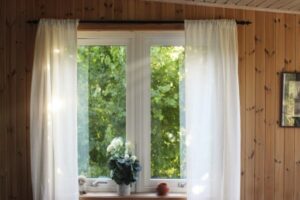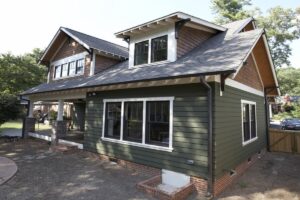Installation errors with Hardie siding can be costly for you. But they’re avoidable simply by hiring a professional contracting company.
James Hardie siding is durable, low-maintenance, and increases the value of your home. But only if it is installed correctly.
Common Installation Errors With Hardie Siding
Not all contractors are created equal. James Hardie siding installation requires specialized equipment and expert knowledge. Inexperienced installers may cut corners or incorrectly install the siding panels. Compromised siding boards can lead to leaking and moisture damage, not to mention your home’s energy efficiency and aesthetics.
1. Improper Clearances
James Hardie siding needs proper clearances between the boards and other surfaces like roofs. Without proper clearances, your boards can fall victim to moisture-related issues.
You may notice the paint is starting to bubble and peel. James Hardie board is usually resistant to moisture damage, but when the boards are wet, the water inside will expand and contract with fluctuating temperatures.
2. Fastener Issues
Fasteners are an essential component of your siding installation, but they can cause issues in the hands of an inexperienced installer.
Common fastener errors are
- Using the wrong type of fastener
- Overdriving or underdriving them
- Failing to follow the recommended spacing
These errors can lead to poor siding attachment and potential siding failure. The last thing you need is your siding blowing off during a storm because it wasn’t fastened properly.
Hardie panels need to be fastened to the studs in a consistent pattern with full-headed screws or nails. James Hardie has tested and approved a variety of nail and screw patterns, and a professional contractor will be familiar with them.
James Hardie siding needs corrosion-resistant fasteners. The nails used during installation should last as long as your siding and warranty. The best nails for Hardie siding are stainless steel, not electro-galvanized. The wrong nails can rust and stain your siding.
3. Joint Gaps
Hardie boards should be touching. Proper flashing and sealants should be installed at the joints to prevent water infiltration. There should also be a slip sheet behind each butt joint in the siding.
4. Devilish Details
Too many contractors skip the vital steps at the end of a project. No installation is complete until the final walkthrough, when the team checks all the little details.
For example, the caulking should match the siding color and be applied neatly. Messy caulking is a common error that ruins the overall look of a siding replacement. Nails should also be touched up to match the siding color. Paint will fade quicker than the baked-on siding color, leaving your siding looking splotchy. James Hardie has a touch-up kit that offers much better results.
Finally, the dust from cutting fiber cement boards is not only bad for contractors but also sticks to the paint and is difficult to remove if left too long. A common mistake is contractors that don’t keep their cutting station clean and clean off any dust immediately.
Siding Installation Green Flags
We’ve looked at a few of the common Hardie installation errors and red flags, but here are a few green flags to watch out for.
- Certified installers with the proper training that follows the manufacturer’s guidelines.
- Flashing installation at the windows, doors, and other vulnerable openings.
- Installers who use house wraps for better moisture resistance and energy efficiency.
- Contractors that pay attention to detail and put customers first.
Avoid Installation Errors with Hardie Siding
James Hardie siding is a significant investment, and you want to put your trust in a company that works to the highest standard.
At Kentucky Home Exteriors, we have a satisfaction policy and won’t accept final payment until you’re 100% happy.
If you’re worried about installation errors with Hardie siding, contact us for a free consultation where we can put your mind at ease.






